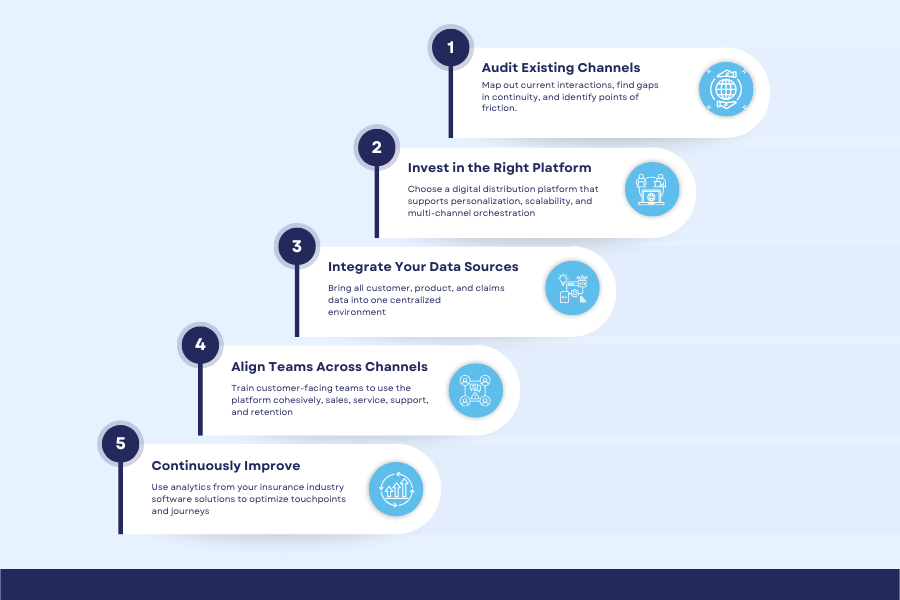
Reports claim “85% of insurance customers expect seamless engagement across all channels; website, mobile app, phone, chat, and in-branch—with 71% specifically emphasizing seamless omnichannel journeys”. To meet this demand, modern insurers are now embracing a transformative strategy: insurance omnichannel distribution.
This shift doesn’t just involve adding more communication channels to ease the insurer’s and policyholder’s relationship. It’s also about integrating diverse insurance channels, smartly yet intuitively, within a single platform and offering an elevated insurance omnichannel distribution experience.
When done right, this evolution reshapes not just how insurers sell, but how they serve and retain their customers. In this blog, let’s explore more about how insurance organizations can imbibe omnichannel insurance experiences on a single platform.
Decoding Basics: The Difference Between Omnichannel and Multichannel
While most insurance companies plan on leveraging an insurance omnichannel platform, the confusion between multichannel and omnichannel remains consistent for every initiator. Let’s eradicate this confusion by having a brief idea about these concepts!
1. Multichannel Services:
In a multichannel customer experience, insurers offer multiple ways for customers to engage, like apps, websites, call centers, or agents, but each channel functions largely individually. There’s no unified system connecting them, so data and conversations remain siloed.
This means if a customer starts a quote online but wants to finish it by calling an agent, they often need to start over or repeat information. While multichannel insurance distribution expands reach, it creates disconnected experiences, frustrates customers, and slows down processes.
2. Omnichannel Services:
On the other hand, an omnichannel insurance distribution is an integrated single platform that offers multiple channels within a single setup. It connects every touchpoint, which enables customers to switch freely between them without losing context.
Whether they initiate a claim on a chatbot, track it via email, or get support from an agent, the entire journey is unified and consistent.
Omnichannel in insurance ensures real-time data synchronization, personalized communication, and a seamless experience that builds trust and drives loyalty across every interaction.
Now that we have an explicit understanding of Omnichannel services, let’s move to the primary agenda of this blog.
The Importance of an Insurance Omnichannel Distribution Platform
Consumer behavior has changed drastically. People interact with brands having personalized demands and through the channel they find most convenient at that moment. With the growth of Fintech, the insurance industry is subject to these changes. Today, customers’ demands
- Fast responses
- 24/7 accessibility
- Personalized recommendations
- Transparent policy terms
- Instant claims processing
If insurers can’t meet these demands across various touchpoints, customers quickly shift to competitors. This is where omnichannel in insurance becomes a game-changer. It enhances customer trust, boosts brand value, and drives long-term loyalty.
How Omnichannel Distribution Insurance Is Transforming Customer Experience?

A true digital distribution platform enables insurers to unify their operations across digital and physical channels. It acts as the central functional system for every insurance process, from marketing to underwriting to claims. Let’s have a brief about it!
1. Customer Relationship Management (CRM):
Offers complete visibility into interactions, behaviors, and preferences. It helps build customer loyalty, enables insurers to build their trust, and scales brand reputation.
2. Automation Engines:
Streamline onboarding, renewals, and claim workflows. Automated engines in an omnichannel digital distribution platform process the entire insurance for the customers without any manual intervention, delays, or hidden processes.
3. Communication Integrations:
Sync emails, SMS, WhatsApp, chatbots, and more. This allows insurers to connect with customers at a personalized level through distinct interaction platforms.
4. Analytics Dashboards:
Provide real-time insights into customer journeys. This data can be utilized for marketing purposes, offering personalized recommendations to customers, and elevating customer experience.
5. AI Tools:
Recommend the next best action based on customer data, provide personalized suggestions, and automate chat or customer support services. These tools also help customers with timely EMI reminders or the auto-cut EMI feature for timely payments.
6. Scalable APIs
Allow seamless connection with partner tools and services. Has automated updates to support the latest market updates and accommodate modern features.
With such exceptional benefits, insurance organizations have come to rethink their conventional or existing insurance distribution platform. The reason is an advanced insurance omnichannel setup, which could address the customer demands without asking them to juggle between diverse touchpoints.
Challenges Without A Unified Omnichannel Platform
Legacy systems and siloed departments make it difficult for insurers to deliver seamless experiences. Here’s what happens when omnichannel efforts are disconnected:
- Broken customer journeys: A conversation started via email doesn’t continue on a call or chat.
- Redundant data entry: Customers have to re-enter details at every stage.
- Disjointed messaging: Offers and policy details vary across platforms.
- Low agent efficiency: Without a 360-degree view, advisors can’t offer tailored suggestions.
- Missed sales opportunities: There’s no timely follow-up or cross-sell triggers.
Benefits of Omnichannel Insurance Distribution Platform

While learning about the multiple challenges a conventional insurance distribution platform faces, you must be wondering about how an omnichannel insurance distribution platform can elevate customer experience. Let’s explore its benefits-
1. Customer-Centric Experience
No more disjointed conversations. Customers enjoy continuity and convenience, which improves satisfaction and loyalty.
2. Operational Efficiency
Unified platforms reduce redundancy, eliminate manual errors, and speed up operations.
3. Enhanced Sales Conversions
By enabling contextual nudges and timely follow-ups, insurers can significantly increase policy issuance rates.
4. Better Agent Performance
Agents gain access to real-time customer data, product insights, and communication history, all in one place.
5. Scalable Growth
With APIs and modular architecture, insurers can expand into new markets, channels, and partnerships easily.
There’s no room for fragmented systems or outdated service models. The competition is already moving ahead, powered by real-time data, AI personalization, and channel agility. That means embracing insurance omnichannel distribution, driven by a future-ready insurance omnichannel platform, is all you need. How? Let’s explore!
How to Instill Omnichannel Insurance Experience

Moving to a true omnichannel strategy isn’t about adding tech on top of old systems. It requires clear steps:
Step 1: Audit Existing Channels
Map out current interactions, find gaps in continuity, and identify points of friction.
Step 2: Invest in the Right Platform
Choose a digital distribution platform that supports personalization, scalability, and multi-channel orchestration.
Step 3: Integrate Your Data Sources
Bring all customer, product, and claims data into one centralized environment.
Step 4: Align Teams Across Channels
Train customer-facing teams to use the platform cohesively, sales, service, support, and retention.
Step 5: Continuously Improve
Use analytics from your insurance industry software solutions to optimize touchpoints and journeys.
Key Takeaways
Today’s customers don’t just expect service; they expect continuity. And in the insurance world, that means delivering a cohesive journey across every interaction point. True insurance omnichannel distribution isn’t just about being everywhere; it’s about being connected everywhere.
That’s exactly what Ensurite helps insurers achieve.
Ensurite’s advanced insurance omnichannel platform bridges the gap between digital and human touchpoints, making transitions feel effortless for both customers and teams. Whether you’re a legacy insurer modernizing your tech stack or a digital insurance company scaling fast, Ensurite offers tailored insurance industry software solutions that unify operations, optimize workflows, and elevate customer trust.
In an industry defined by trust and timing, don’t settle for fragmented systems. With Ensurite, create the kind of omnichannel experience that not only meets expectations, but quietly exceeds them.
Explore more Blogs: https://ensurite.ai/blog/
Frequently Asked Questions
Why is creating an omnichannel experience important for insurers?
In the mobile-first world, omnichannel presence in the insurance industry offers customers a competitive edge in the market. Moreover, it provides insurance companies with a vast scope to offer customers enhanced quality services. It eventually results in meeting the evolving expectations of tech-savvy customers and drives a better customer retention rate.
What technologies are essential for building an omnichannel insurance platform?
To build an omnichannel insurance platform, it is required to integrate diverse technologies that ensure a smooth platform performance across digital and physical channels. Below are some essential technologies that are required to develop an effective insurance omnichannel distribution platform:
- Customer Data Platform
- API Management and Integration Layer
- Modular Microservices Architecture
- Digital Experience Platforms (DXPs)
- AI & Machine Learning
- Core Insurance Systems Integration
- Identity & Access Management (IAM)
- Omnichannel Communication Platforms
- Analytics & Reporting Tools
- Compliance & Security Tools
Can smaller insurance providers also implement omnichannel solutions effectively?
Yes, even smaller insurance providers can also implement omnichannel solutions effectively. However, it is essential to pre-define the priorities, choose the strategic approach, and the right tools.
What role does AI play in enhancing omnichannel insurance experiences?
AI enhances omnichannel insurance platform efficiencies through digital, self-service claims processes and omnichannel communication tools. These tools include chatbots, which improve both speed and customer satisfaction. In fact, AI can automate the entire insurance process, which means from registration to distribution, AI will take care of it all!
